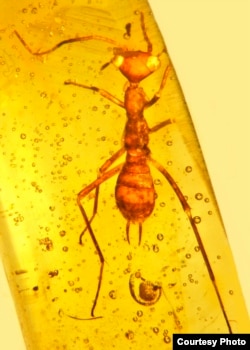Even to an untrained eye, the 100-million-year-old insect that American entomologists are showing off this week looks a bit strange.
Experts say the slender, long-legged tree-dweller is unique among the more than 1 million insects that science has identified. It is so different, in fact, that a new scientific order has been created to describe it.
After extensive analysis, a team at Oregon State University has assigned the insect to the new biological order Aetheocarinodea, the 32nd classification of groups of insects recognized by science.
As seen frozen in amber, the wingless insect has a triangular head, with large eyes at the two widest points, giving it the ability to look in any direction. The bug moved quickly over tree bark, looking in crevices for its prey — most likely mites, tiny worms or fungi — and it lived in Myanmar at a time when dinosaurs roamed the Earth, according to the OSU scientific team.
"This insect has a number of features that just don't match those of any other insect species that I know," said George Poinar, an OSU entomologist considered to be one of the world's leading experts on plant and animal life forms found preserved in amber.
"I had never really seen anything like it,” he said. “It appears to be unique in the insect world, and after considerable discussion we decided it had to take its place in a new order."
The ancient insect, whose species is designated as Aethiocarenus burmanicus, had a gland at the base of its neck that probably secreted a substance to repel predators.
After a thorough analysis, scientists concluded that each of its strange, bulging eyes could cover a field of view of almost 180 degrees — meaning it literally could see behind, as well as forward.
Only two specimens of the strange insect have ever been found. They both have been assigned to the same species, and they "comprise the totality of the order Aetheocarinodea," according to a university spokesman in Corvallis, Oregon.
"The strangest thing about this insect is that the head looked so much like the way aliens are often portrayed," Poinar said. "With its long neck, big eyes and strange oblong head, I thought it resembled [the alien from the movie] E.T. [the Extra-Terrestrial]. I even made a Halloween mask that resembled the head of this insect. But when I wore the mask when trick-or-treaters came by, it scared the little kids so much I took it off."









